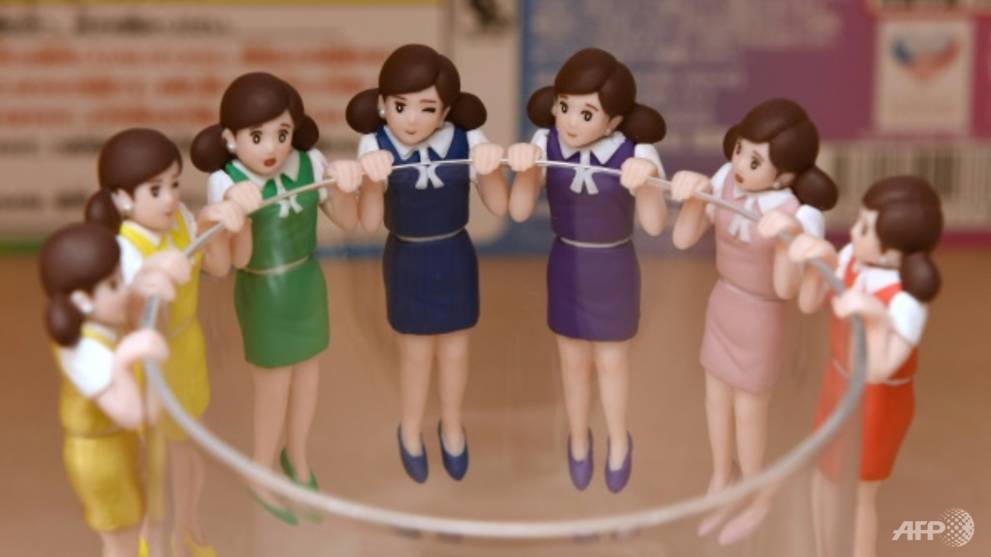Weird but cute: Japan's capsule toys play big in Internet age
 |
| Tokyo-based manufacturer Kitan Club fueled the craze for capsule toys when it launched a special figurine of a woman wearing a typical office worker's clothes, whose arms or legs were designed to hang over the edge of a glass. (Photo: AFP/Kazuhiro Nogi) |
The industry is now worth an estimated ¥30 billion (US$265 million), with the fastidious attention to detail in the toys appealing to the Japanese sense of precision along with a well-documented love of all things "kawaii" or cute.
One store, in Tokyo's famous Akihabara electronics district, is crammed with around 500 capsule toy vending machines stretching out as far as the eye can see.
"When I see something I want, I keep on turning the crank until I get it," said Shota Makita, a 23-year-old careworker on the hunt for a fun toy.
"There's a sense of excitement about not knowing what I'll get," said Makita, one of a growing number of adult consumers of capsule toys, known as "gachagacha" or "gachapon" in Japanese after the cranking sound.
Store manager Yo Kono says the customer base has changed in the 16 years the shop has been open.
"At the beginning, visitors were mainly male anime fans ... but recently the number of customers is growing with more female visitors and foreign tourists," Kono said.
'CHEAP AND INSTAGRAM-WORTHY'
Capsule toys have been around for more than 40 years but the craze really took off in 2012 when Tokyo-based manufacturer Kitan Club launched its "Koppu no Fuchico" ("Fuchico at the edge of a glass") product.
This figurine of a woman wearing a typical office worker's clothes, whose arms or legs were designed to hang over the edge of a glass, became an instant hit with adults.
"We never thought of targeting children. Their numbers are dwindling and adults have more money," said spokesman Seita Shiki.
Shiki chalks up the Fuchico capsule's success to the fact it is "cheap and Instagram-worthy."
Fans have been sharing photos of Fuchico on social media, which helped boost its popularity without the company even needing to advertise, he boasted.
"Fuchico was launched just as social media started to be used widely. It fitted with the times."
Kitan Club, which makes various kinds of capsule toys, saw its sales grow from ¥800 million to ¥1.2 billion after the launch of the Fuchico series.
The capsule toy became so popular that the company was asked to create a pop-up shop at the cult Paris concept store Colette and to hold an exhibition in Taiwan.
'VERY JAPANESE'
Now many manufacturers are making capsule toys to appeal to adult consumers, helping to expand the market to around 100 new items each month.
Manufacturer Bandai, which occupies around 70 per cent of the capsule toy market, said the products sell well because they are expertly made and they come in huge varieties.
When Bandai began making capsule toys exactly 40 years ago in 1977, the majority of them were cheap, sold mostly at ¥20, and were of poor quality, general manager Toshikazu Saita said.
"A wide variety of quality products are available at only ¥200 or ¥300. I think that's a reason why they're so popular now," said Saita.
He said the quality of the products was down to specialists who "hand-carve prototypes by paying attention to angles and colours."
"The attention to detail is very Japanese," he said.
But to keep costs down, the actual toys are manufactured in China using the Japanese design as a prototype.
Shiki of Kitan Club agreed that attention to detail was what set Japanese capsule toys apart.
"For example, Fuchico's knees and elbows are slightly sprayed with red paint to make them look real," he explained. "This adds one extra step but we feel we have to do this" even if it adds to the cost, he added.
It certainly appeals to Nana Sakuma, 26, who snapped up four capsule toys in the shape of Japanese food stalls from machines in the Akihabara store.
She said: "I'm really happy to find toys that are so real. When I see real things turned into miniatures, I find them irresistibly cute. I cannot help but buy them.
What the stars mean:
★ Poor ★ ★ Promising ★★★ Good ★★★★ Very good ★★★★★ Exceptional
Latest News
More News
- Free tickets, Lunar New Year promotions on offer at Vietjet Mega Livestream (November 26, 2025 | 15:32)
- UNIQLO unveils upgraded heat-retention wear at Hanoi event (October 26, 2025 | 10:00)
- Vietnam named among world’s top four culinary destinations (October 24, 2025 | 17:09)
- Vietnam and Denmark strengthen dialogue on sustainable fashion (October 20, 2025 | 09:11)
- Fusion rolls out special initiatives to celebrate Vietnamese Women’s Day (October 17, 2025 | 20:00)
- Showcase AC 2025 set to light up Hanoi stage (September 12, 2025 | 18:06)
- Hotel Indigo Saigon The City hosts event to reimagine city’s beloved alleyways (July 23, 2025 | 17:04)
- UNIQLO’s sustainability strategy behind the brand's global growth (June 23, 2025 | 15:42)
- Vietnam International Travel Mart 2025 kicks-off in Hanoi (April 10, 2025 | 17:50)
- Phu Quoc named as one of Asia's 'Best Islands' (March 13, 2025 | 10:24)


















 Mobile Version
Mobile Version